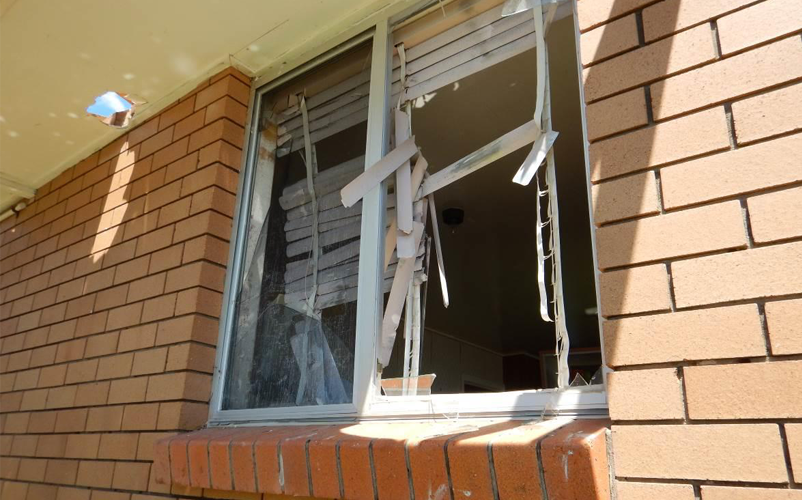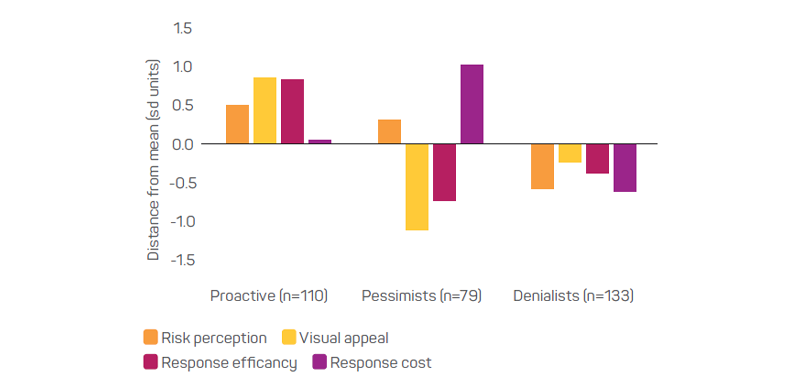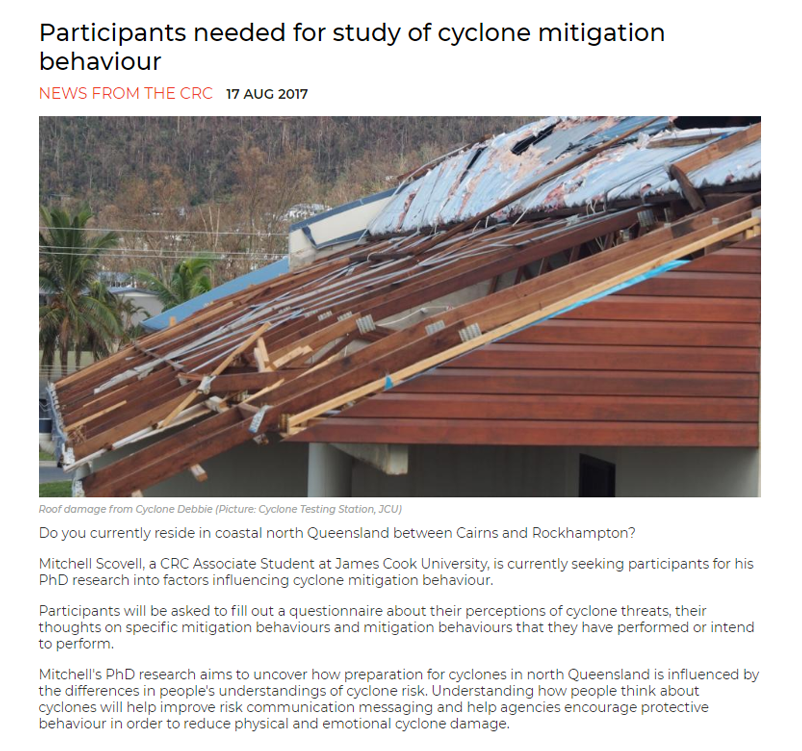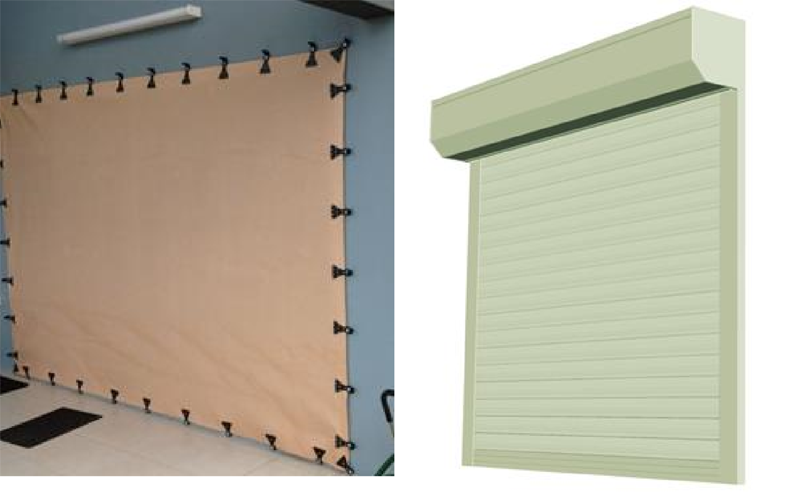Cyclones cause significant damage to property, infrastructure and housing. Fortunately, property owners can undertake structural upgrades to reduce damage. However, installation of structural upgrades in cyclone-prone regions such as North Queensland has been relatively low. This paper explains why some people do, and others do not, install structural upgrades. Research to date has identified psychological factors that may predict mitigation behaviour for other natural hazards, but there are few studies that investigated cyclone-specific mitigation behaviour. This paper addresses this gap and identifies the psychological factors that promote mitigation behaviour for structures and presents a method of segmenting groups based on these psychological factors. Implications for risk communication messages to promote the adoption of household-level structural upgrades are discussed.
Based on a presentation at AFAC19 – the annual conference of AFAC and the Bushfire and Natural Hazards CRC.
Introduction
In Australia, tropical cyclones caused over $6 billion in insured damage between 2006 and 2016 (Harwood, Smith & Henderson 2016). Housing is particularly vulnerable as cyclones can cause significant structural damage (Smith, Henderson & Ginger 2015). However, some of this damage is preventable if appropriate structural measures are in place, for example, cyclone shutters can be installed to reduce window damage caused by cyclones (Smith, Henderson & Ginger 2015). Despite these benefits, installation of cyclone shutters is low in high-risk areas such as North Queensland (Harwood, Smith & Henderson 2016). This paper identifies some of the psychological factors that explain why people choose to invest or not in cyclone shutters. A method of segmenting risk communication messaging is investigated with the aim of improving the uptake of structural damage mitigation measures.
Past research has identified a range of psychological factors that help predict mitigation behaviour for natural hazards (Koerth, Vafeidis & Hinkle 2016; Bubeck, Botzen & Aerts 2012; Kellens, Terpstra & de Maye 2013; Smith et al. 2016; Kanakis & McShane 2016). Psychological factors are considered better predictors of mitigation behaviour than demographic factors (Lindell & Hwang 2008; Peacock 2003, Ge, Peacock & Lindell 2011). In particular, psychological factors within two popular psychological models, the Protective Action Decision Model (PADM) and the Protective Motivation Theory (PMT), have been found to be reliable predictors of mitigation behaviour (Bubeck et al. 2013; Poussin, Botzen & Aerts 2014; Grothmann & Reusswig 2006; Terpstra & Lindell 2013; Ge, Peacock & Lindell 2011). Although the conceptualisation of factors within these models differs, most studies have found that perceived threat (threat appraisal) and perceived ability to respond to the threat (coping appraisal) are significant predictors of mitigation behaviour.
By identifying the psychological factors that relate to cyclone mitigation behaviour, effective risk communication messages can be built on these findings (Kellens et al. 2013). However, using a one-size-fits-all approach to risk communication means some people may not receive or heed the information (Fekete 2012). People-centred risk communication messaging, which acknowledges the psychological differences between groups, outperforms traditional approaches of giving everyone the same message (Haer, Botzen & Aerts 2016). One way to implement a people-centred approach is to understand how groups differ based on psychological predictors of mitigation behaviour and tailoring messages to address these differences. Creating a ‘typology’ or ‘cluster’ groups based on psychological factors has been successfully applied to gain good understanding of how different groups respond during bushfires (Strahan, Whittaker & Handmer 2018) and adaptation to coastal flooding (Koerth et al. 2014). This study uses a similar approach to identify the differences in peoples’ perceptions towards cyclones and cyclone shutters and how these differences relate to intentions to undertake structural changes to their homes.

Windborne debris failure of a window without opening protection in Yeppoon, following Tropical Cyclone Marcia.
Image: Courtesy Smith, Henderson & Terza (2015)
Method
Participants
Respondents were recruited using social media platforms of Facebook and Twitter. Links to an online survey were promoted and were also shared through other social and professional networks. Information about the survey was disseminated via broadcast media platforms throughout North Queensland (i.e. TV, radio and newspapers). People who were living in coastal North Queensland between Cairns and Rockhampton were able to respond.
This survey was part of a larger research project that assessed many different factors. However, the focus of this study was to investigate home owners’ structural mitigation behaviours. As such, only home owners who provided information about their cyclone mitigation behaviours or intentions were included in the analysis.
Respondents were asked to report their gender, age, relationship status, years spent in North Queensland, income and their highest level of formal education. They were also asked to specify if they had any dependent children and if they had experience with cyclone-related property damage.
After removing ineligible responses, the final response sample size was 339, with 112 (33 per cent) males and 227 (67 per cent) females. The average age of respondents was 47 years with a standard deviation of 11.9 years and a range of 18 to 76 years. The median household income category was $80,000–$125,000. A bachelor’s degree was the most commonly reported highest level of education (31 per cent). The average number of years living in North Queensland was 25.5 years with a standard deviation of 17.3 years and a range of 1 to 75 years. Most frequently, respondents reported that they were married (68 per cent) and 50 per cent had at least one dependent child.
Materials
Shutter installation
A shutter installation variable was used to assess cyclone mitigation behaviour as all home owners can install shutters and their primary use is to mitigate cyclone-related property damage. The shutter installation variable was created by combining scores from two other variables: shutter installation behaviour and intention to install shutters.
First, behaviour was assessed by asking respondents if they had installed cyclone shutters since building or buying their property. If respondents indicated they had not installed cyclone shutters, they were asked to indicate how likely they were to install them in the coming five years. Intention to install shutters was measured on a seven-point Likert scale with higher scores indicating a higher intention to install shutters.
There were minimal responses to some levels of the seven-point intention scale so scores were combined to create three ordered categories (i.e. a low, moderate and high intention group). The shutter installation variable was the outcome variable used in the subsequent analysis and was scored as follows:
- low intention to install shutters
- neither likely nor unlikely to install shutters
- likely to install shutters
- already installed shutters.
Examples of commercial shutters for window protection.
Image: Smith, Henderson and Ginger 2015
Mitigation and resource perceptions
Risk perception was assessed based on five questions. Using a similar operationalisation to Peacock and colleagues (2005), questions assessed perceptions of:
- damage likelihood
- the extent to which people’s daily lives and ability to work would be affected
- the extent to which their mental and physical health would be negatively affected.
Other psychological factors based on the PADM/PMT were also assessed, as shown in Table 1. Variable conceptualisation was adapted from the study by Terpstra and Lindell (2013) but was defined using PMT terms (i.e. response efficacy and response cost). The ‘factors’ in column 1, Table 1 were created by summing and averaging the scores of subscales of risk perception, response efficacy and response cost. All subscales were scored on a 7-point Likert scale, with higher scores indicating stronger agreement with each statement.
Table 1: Scoring of psychological factors
| Factors | Statements |
| Response Efficacy | |
| Efficacy (damage) | Shutters are effective for reducing property damage and associated costs. |
| Efficacy (safety) | Shutters are effective for increasing family’s safety. |
| Utility | Shutters are useful for other purposes besides protecting property. |
| Increases value | Shutters increase property value. |
| Response Cost | |
| Monetary cost | Shutters are expensive to install. |
| Time and effort | Shutters take a long time and a lot of effort. |
| Knowledge/skill required | Shutters take a lot of skill and knowledge to get installed. |
| Cooperation required | Shutters require a lot of help/cooperation from others. |
| Visual Appeal | |
| Visual appeal | Shutters are visually appealing. |
| Self-efficacy | |
| Self-efficacy | Requires the ability of the respondent or a family to organise for the shutters to be installed. |
Procedure
Ethical approval was obtained through the James Cook University Human Research Ethics Committee (#H7007). The survey was available online using the Qualtrics platform and took approximately 25 minutes to complete. Most of the respondents were recruited online between the 30 June and 9 November 2017. The survey was first disseminated via social media platforms such as Facebook and Twitter and a Facebook page was created providing information about the study and a link to the survey.
Table 2: Results of an Ordinal Regression Analysis
| Psychological factors | Coefficient | p |
| Response efficacy | 0.436 | 0.001 |
| Response cost | -0.315 | 0.004 |
| Self-efficacy | 0.007 | 0.923 |
| Visual appeal | 0.343 | <0.001 |
| Risk perception | 0.277 | 0.022 |
Note: In total, the variables explained 24 per cent of the variability in the model (Nagelkerke R2 = 0.24).
Results
Psychological factors that predict shutter installation
Ordinal regression was used to determine the psychological factors that predict shutter installation. As shown in Table 2, response efficacy, response cost, visual appeal and risk perception were all significant predictors of shutter installation (all p<0.05). Self-efficacy, however, was not. In total, the variables explained 24 per cent of the variability in the model, which suggests that the significant predictors in the model are important for explaining shutter installation behaviour.
Cluster analysis
K-means cluster analysis was used to divide respondents into groups based on their standing on four psychological variables. The psychological variables used in the cluster analysis were risk perception, response efficacy, response cost and visual appeal. The four variables were converted to Z-scores before analysis. Three cluster groups were chosen for the k-means analysis. Figure 1 shows each cluster group’s standing relative to the mean on each factor used in the cluster analysis. The numbers on the y-axis represent standard deviation units (or Z-scores).
As seen in Figure 1, cluster groups were given names to represent the average perceptions of the group. The first group was labelled ‘proactive’ because, compared to other groups, they perceived the highest levels of risk, the highest level shutter efficacy and visual appeal, and perceived a moderate level of response cost. The second group, ‘pessimists’, perceived slightly less risk than the proactive group but perceived the lowest level of efficacy and visual appeal of shutters and the highest level of response cost. The last group, ‘denialists’, perceived the least risk, a moderate level of shutter efficacy and visual appeal and the least response cost.

Figure 1: Cluster group relative standing on perceptual factors.
Clusters and mitigation behaviour
A chi-square test was used to determine the relationship between cluster groups and shutter installation intention. The results of the chi-square test show there was a significant association between cluster groups and shutter installation (x2(6)=41.98, p<0.001).
Table 3 shows the number of people in each cluster group who have also installed cyclone shutters (group count). The expected count represents the projected number of respondents if there was no association between variables. The percentage of people from each cluster group who responded to each shutter installation option is also shown. Table 3 shows that most respondents who said they had already installed shutters belonged to the proactive cluster group. Similarly, the majority who were likely to install shutters in the future were also part of the proactive cluster group. Conversely, most of the respondents who said they were unlikely to install shutters in the future were either in the pessimists or denialists cluster groups.
Table 3: The association between cluster groups and shutter installation behaviour.
| Cluster groups | Unlikely | Neither likely or unlikely | Likely | Already installed |
| Proactive group count | 43 | 37 | 20 | 10 |
| Proactive expected count | 65 | 30 | 11 | 4 |
| Proactive % within shutter installation response | 23% | 42% | 63% | 77% |
| Pessimist group count | 63 | 12 | 3 | 1 |
| Pessimist expected count | 46 | 22 | 8 | 3 |
| Pessimist % within shutter installation response | 33% | 14% | 9% | 8% |
| Denialists group count | 83 | 39 | 9 | 2 |
| Denialist expected count | 78 | 36 | 13 | 6 |
| Denialist % within shutter installation response | 44% | 44% | 28% | 15% |
Clusters and demographic factors
Analysis identified demographic factors that differentiated cluster groups. Three types of statistical analysis were used depending on the scale of measurement. One-way analysis of variance was used for scale variables (e.g. age), Kruskal-Wallis H test for ordinal variables (e.g. income) and chi-squared for nominal variables (e.g. gender of respondent). Table 4 shows the variables that were significantly associated with cluster groups (p<0.05) and those that were not (p>0.05).
Tukey post-hoc tests indicated that those in the proactive group (M=28.46, SD=18.18) had lived in North Queensland significantly longer than those in the pessimists group (M=21.43, SD=15.05). There was no significant difference between any other cluster pairs. The denialists group had the highest levels of income and education. Conversely, the proactive group had the lowest level of formal education and almost the lowest levels of income. The results also showed differences in types of cyclone experience. The pessimists group were more likely to have not experienced a cyclone, the denialists group were more likely to have experienced a cyclone causing no property damage and the proactive group were more likely to have experienced a cyclone that caused moderate property damage.
| Significant | Not significant |
| Years in North Queensland (p=0.02) | Gender |
| Income (p=0.03) | Age |
| Education (p=0.01) | Dependant child |
| Cyclone experience (p=0.02) | Marital status |
Discussion
This study identified the psychological factors that predict cyclone mitigation behaviour to develop groupings of people based on these factors. It was found, in accordance with the theory behind the PADM/PMT, that perceived risk, mitigation efficacy and low resource costs were significant predictors of behaviour. The perceived visual appeal of structural mitigation, an uncommonly investigated factor in previous research, was found to be one of the strongest predictors of mitigation behaviour. However, self-efficacy was not a significant predictor of shutter installation. This finding suggests that the perceived ability for a home owner to organise the installation of cyclone shutters does not inhibit mitigation intention or behaviour.
Respondents were categorised into three groups based on attitudes towards cyclones and structural mitigation. The proactive group, who scored highly on both threat and coping appraisal (using PMT terminology), were more likely to have installed shutters or were more likely to endorse installing them in the future. This contrasts with the denialists and pessimists groups who perceived lower levels of threat and coping appraisal. These two groups were less likely to have installed shutters and less likely to intend to do so in the future. In other words, protective behaviour is more likely to occur when people have high levels of both threat and coping appraisal. The difference in behaviour and intention between these groups provides further support for the usefulness of the PMT/PADM in predicting variations in behaviour. Future research could investigate if similar psychological clusters can be identified in different cyclone-prone regions (outside of North Queensland) and in relation to other natural hazards (e.g. floods).
This study shows that it is possible to differentiate cluster groups using demographic information. This finding has important practical implications. For example, governments and insurance companies interested in delivering tailored risk messaging can segment people using demographic data without having to assess attitudes towards cyclones and structural mitigation. However, it is important to highlight that while the results show that differentiating cluster groups based on demographic information is possible, more research is needed to explain why specific links were found. Future research should focus on whether it is possible to accurately identify psychological clusters using demographic factors. This research would allow stakeholders to confidently disseminate tailored messages based on demographic information.
Types of cyclone experience was also shown to differentiate cluster groups. The proactive group was more likely to have experienced moderate property damage from a cyclone compared to other groups. This suggests that previous experience with cyclone and damage helps people realise the damage potential of a cyclone as well as the importance of structural mitigation. This reasoning explains why people who have experienced a cyclone that did not cause property damage were more likely to have ‘denialist’ attitudes. Experience with a cyclone that results in no damage may lead to people discounting cyclones as a threat and, therefore, thinking that structural upgrades are not necessary.
Finally, the pessimists group was more likely to have not experienced a cyclone. Without direct experience, attitudes towards cyclones can only be formed from what they have seen or heard from other people. As such, they may have only heard about the destructive potential of cyclones (commonly reported in news media) without hearing about effective methods for mitigating damage. People in the pessimists group may think that cyclone damage cannot be avoided. These findings suggest that until property damage from a cyclone has been experienced first-hand, people are less likely to understand and acknowledge the benefits of structural mitigation. It is important and beneficial to find ways to give people the experience of a cyclone and its destructive potential without experiencing the event or the damage.

Recruitment article posted by the Bushfire and Natural Hazards CRC.
Image: Bushfire and Natural Hazards CRC (2017)
Communicating with cluster groups
The findings suggest that risk communication messaging aimed at promoting structural mitigation should be tailored to the target audience. As the pessimists group already acknowledge cyclones as a threat, they could be provided with information about the benefits of structural upgrades and how the long-term benefits of upgrades outweigh the upfront costs. The denialists group may benefit from messages that explain the damage potential of cyclones. The proactive group already have perceptions that are indicative of mitigation behaviour, so messaging should provide cues to make investing in structural mitigation easier. For example, insurance companies or governments could provide contact information for contractors who can install structural upgrades. Future research could investigate if this targeted approach to risk communication improves the uptake of structural upgrades in cyclone-prone regions.



